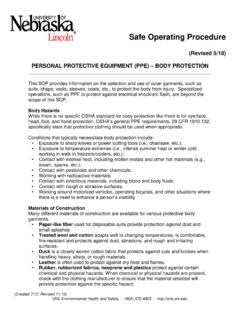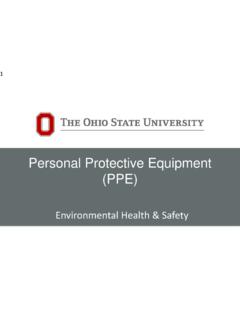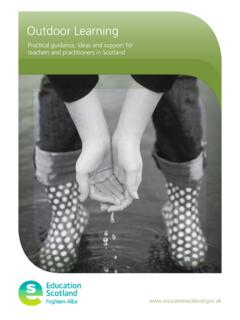Transcription of Personal Protective Equipment (PPE) Safety Program
1 Personal Protective Equipment Safety Program pg. 1 Personal Protective Equipment (PPE) Safety Program ENVIRONMENTAL HEALTH & Safety Personal Protective Equipment Safety Program pg. 2 Table of Contents A. Introduction And Purpose .. 4 B. Background .. 4 C. Policy .. 4 D. Personal Protective Equipment Hazard Assessment .. 4 E. Responsibilities .. 5 1. Department .. 5 2. Environmental Health And Safety .. 5 3. Supervisor .. 5 4. Employee .. 5 F. Personal Protective Equipment Policy .. 6 1. Footwear .. 6 2. Eye .. 6 3. Respiratory .. 7 4. Head .. 8 5. Hand .. 8 6. Gloves .. 8 7. Coveralls .. 8 8. Rain Gear .. 9 9. Hearing .. 9 10. Other PPE .. 9 Personal Protective Equipment Safety Program pg. 3 G. Students And Temporary Employees .. 9 H. Training .. 9 I. Personal Protective Equipment Hazard Assessment Form .. 10 J. Program Review Documentation .. 10 Appendix A: PPE Hazard Assessment And Certification Form.
2 11 Personal Protective Equipment Safety Program pg. 4 Personal Protective Equipment (PPE) Safety Program A. Introduction And Purpose To protect University Employees who work in areas where physical hazards or the potential for physical hazards exist. In certain job classifications there might be Personal Protective Equipment (PPE) needed to protect the Employees while performing various duties. The Program also provides direction to Departments, Supervisors, and Employees about their responsibilities in the selection , use, care and disposal of PPE. B. Background Information The Oregon Occupational & Safety Health Administration (OR-OSHA) and American National Standards Institute (ANSI) standards require protection for the head, eyes, ears, skin, feet, hands, respiratory system, and/or body, etc. under certain hazardous working conditions. C. Policy This is a general PPE policy to reinforce the need to protect Employees from known hazards in the workplace and to outline the process for accomplishing this.
3 Wearing Personal Protective Equipment does not eliminate the hazardous condition through engineering and/or administrative control strategies. A general rule to follow is "use of Personal Protective Equipment (PPE) is required when there is a reasonable probability that injury or illness can be prevented by such Equipment ." Reasonable engineering controls, such as increased ventilation, better guarding or soundproofing, etc. are preferable to PPE. When Employees are required to wear PPE, the cost of that Equipment will be considered a Department expense. Once the PPE Hazard Assessments are completed the only time they will need to be updated is if there is a change in the job duties that require a modification in the PPE being use by the Employee exposed to the possible new hazards. At that time the PPE Hazard Assessment will be updated to reflect those changes and the Employees retrained on changes in PPE for the job.
4 D. Personal Protective Equipment Hazard Assessment PPE and devices should be required only when it is impossible or impractical to eliminate a hazard or control it at its source through engineering design. If it is not possible or feasible to eliminate hazardous conditions, PPE will be used to establish a barrier between the exposed Employee and the hazard to reduce the probability and severity of an injury. Personal Protective Equipment Safety Program pg. 5 OR-OSHA requires PPE Hazard Assessments of workplace jobs to help identify individual job related hazards. PPE Hazard Assessment Forms for each job are being developed and reviewed by Departments in conjunction with the Environmental Safety and Health (EHS) Office. These PPE Hazard Assessment Forms will be reviewed by the Supervisor and train the Employee prior to the beginning of any new job task to determine the appropriate use of PPE.
5 The correct PPE will be available at each Department through each Supervisor. E. Responsibilities 1. Department Departments will be responsible for: a. Carrying out the PPE Program elements in accordance with this written document, along with job specific elements. b. For funding PPE Program expenses, including obtaining the proper PPE needed for each job duty with hazard exposures according to the PPE Hazard Assessments. c. Will be supportive in helping the Supervisors collaborate with EHS to develop and review PPE Hazard Assessments as needed. 2. Environmental Health and Safety EHS will be responsible for review and administration of the PPE Safety Program guidelines. 3. Supervisor Supervisors involved with Employee and Student/Temporary Employee PPE will be responsible for: a. Identifying Employees who have job duties that historically require PPE. b. Providing PPE training to Employees for job duties with known hazards.
6 C. Maintaining Employees job-specific PPE training records. d. Ensuring Employees are aware of and following this written PPE Program and job-specific training. e. Enforce the proper use of PPE by Employees, Students, and Visitors. f. Work with EHS to develop the PPE Hazard Assessments for various jobs in the Department. g. Regularly assessing Employees job duties for previously unidentified hazards and work with EHS in evaluating the need for a change in the PPE type and/or use. 4. Employee Employees using required job related PPE will be responsible for: a. Following the UO s Written PPE Program . b. Adhering to PPE training procedures. c. Properly wearing and using required PPE. d. Reporting defective PPE. Personal Protective Equipment Safety Program pg. 6 e. Reporting an unidentified hazard to your Supervisor that might call for changes in the PPE being used. F. Personal Protective Equipment Policy PPE and clothing provided by the Department are the property of the University.
7 All items that are issued are only for use by Employees for work-related purposes. They are not to be sold or transferred to third parties. Upon the end of the PPE and clothing life-cycle or employment termination, all items must be returned to the Supervisor. Follow the required PPE and clothing procurement procedures of the individual Departments. Supervisors are responsible for keeping clothing and PPE Equipment records. Required PPE is provided at no cost to the Employee. Some additional PPE or other necessary clothing will be provided as needed for each Employee. Specific policies relating to job specific PPE are outlined in each Department s PPE procedures. 1. Footwear Employees must wear Protective footwear when working in areas where there is a danger of foot injuries due to falling or rolling objects, or from object piercing the sole, and where employee s feet are exposed to electrical hazards.
8 In line with the OR-OSHA PPE standard, the following examples of trades required to wear Safety shoes or boots during normal performance of job duties include: a. Stores Personnel b. Carpenters c. Electricians d. Equipment Repair Shop e. Plumbers f. Mechanics (Pipe Fitters, Steam Fitters, Welders, Sheet Metal Workers, HVAC Technicians) g. Trades Maintenance h. Exterior Maintenance & selected Grounds Workers i. Laborers, Heavy Equipment Operators & selected Shop Personnel Other trades or specific tasks may be assessed by a Supervisor and EHS to also require Protective footwear. 2. Eye OR- OSHA requires that appropriate eye protection be provided to and worn by Employees whose jobs expose them to eye injury hazard exposures that include flying Personal Protective Equipment Safety Program pg. 7 particles, molten metal, liquid chemicals, acids or caustic liquids, chemical gases or vapors, or potentially injurious light radiation, etc.
9 The minimal acceptable form of eye protection is Safety glasses that meet ANSI standard American National Standard Practice for Occupational and Educational Eye and Face Protection . Different styles of eye protection are available in the Department where it is required. Visitors will be required to use Safety glasses and be provided at the entrance to locations requiring their use by the Department of those areas. Appropriate eyewear shall be worn in locations when machinery is in operation. For specific tasks or areas that Safety glasses are required please refer to the PPE Hazard Assessment Forms for those locations. In some cases more than one type of eye protection are required to be worn at the same time in a layered manner, such as a face shield over Safety glasses/goggles while grinding. Prescription Safety glasses are available to those Employees who are unable to perform their work in a safe and efficient manner using over-the-glasses style.
10 Prescription Safety glasses must have permanently affixed side shields and also meet the ANSI standard According to the OR-OSHA PPE standard, each affected Employee who wears prescription lenses while engaged in operations that involve eye hazards shall wear eye protection that incorporates the prescription in its design or wear eye protection that can be worn over the prescription lenses without disturbing the proper position of the prescription or Protective lenses. 3. Respiratory Employees will use appropriate respiratory protection when adequate ventilation or substitution with non-toxic chemicals, etc., is not possible or feasible. EHS is responsible for managing this type of PPE under the UO s Respiratory Protection Program . A Supervisor will recommend the Employee s need for a respirator to perform specific job duties based on the history of the job s PPE requirements. Upon enrollment in the Respiratory Protection Program , the Employee will receive an OR-OSHA code required medical questionnaire to fill out.







